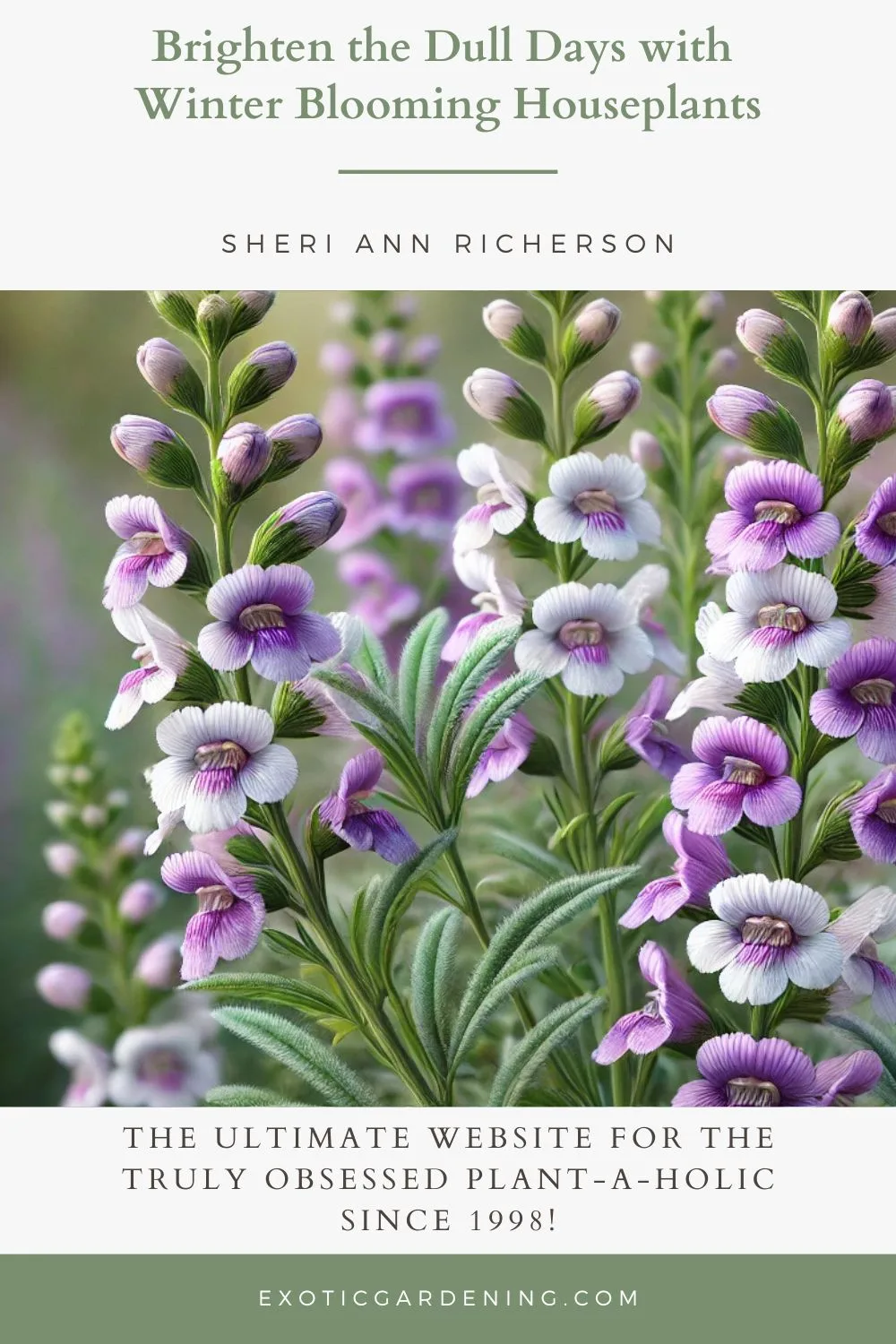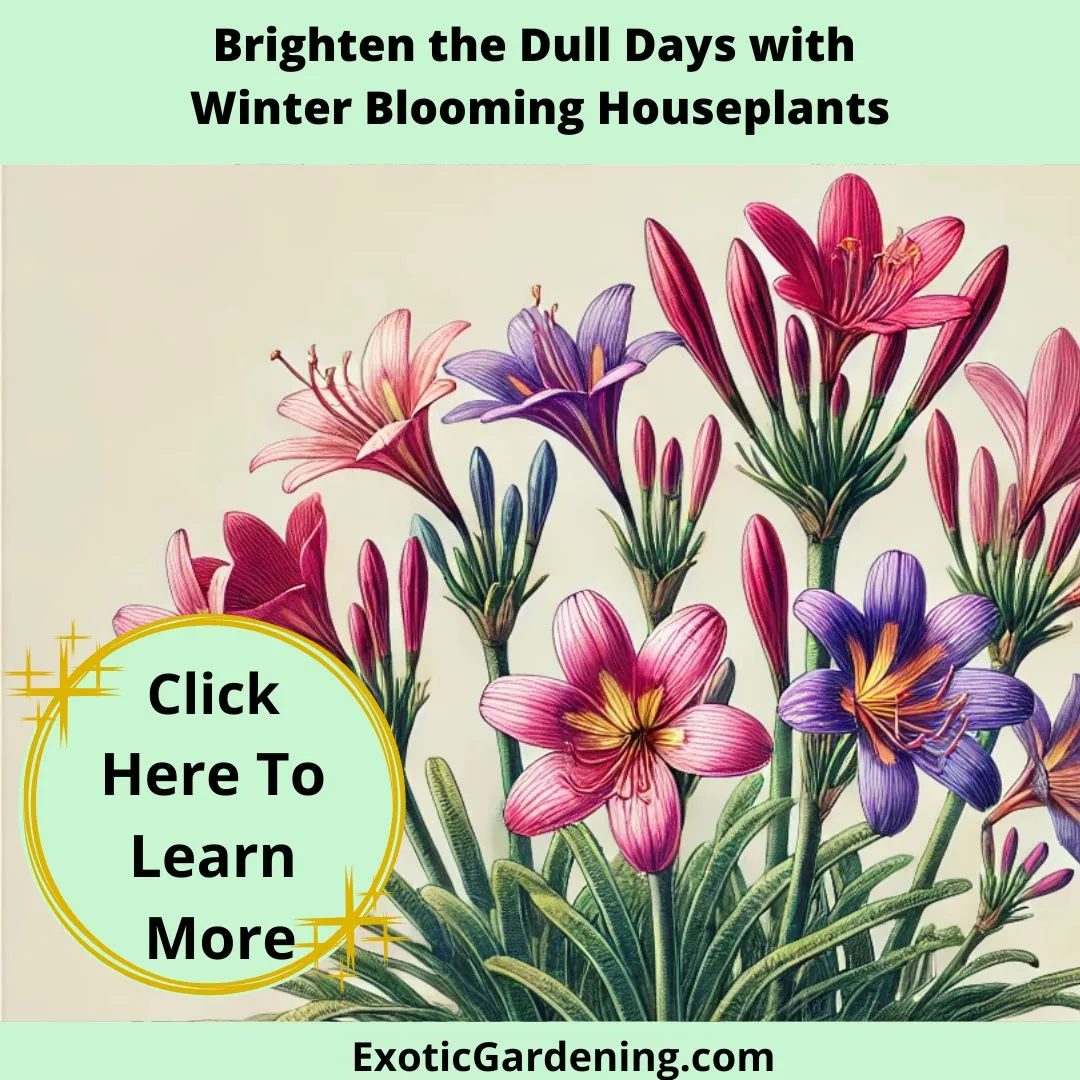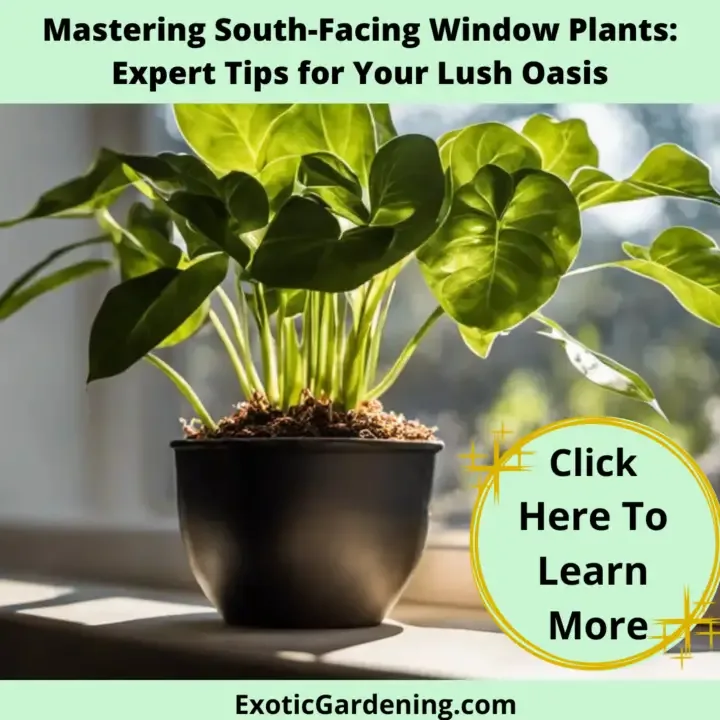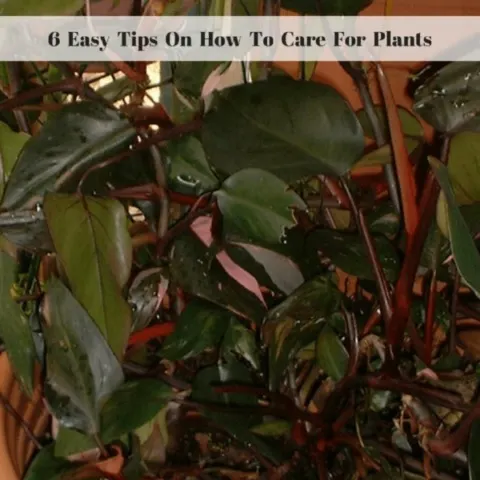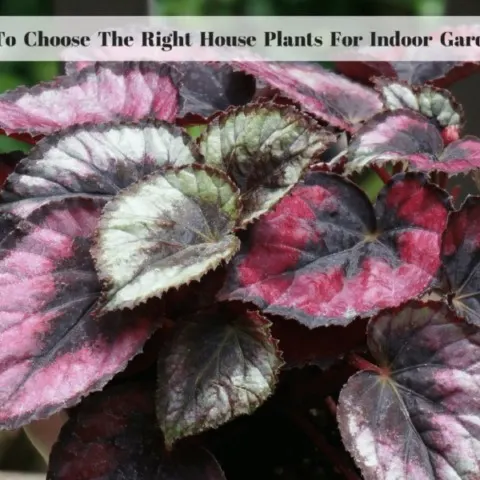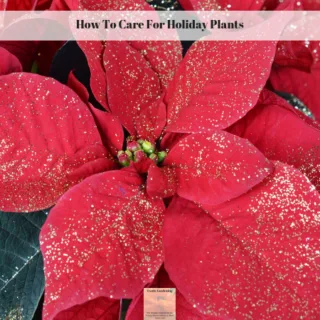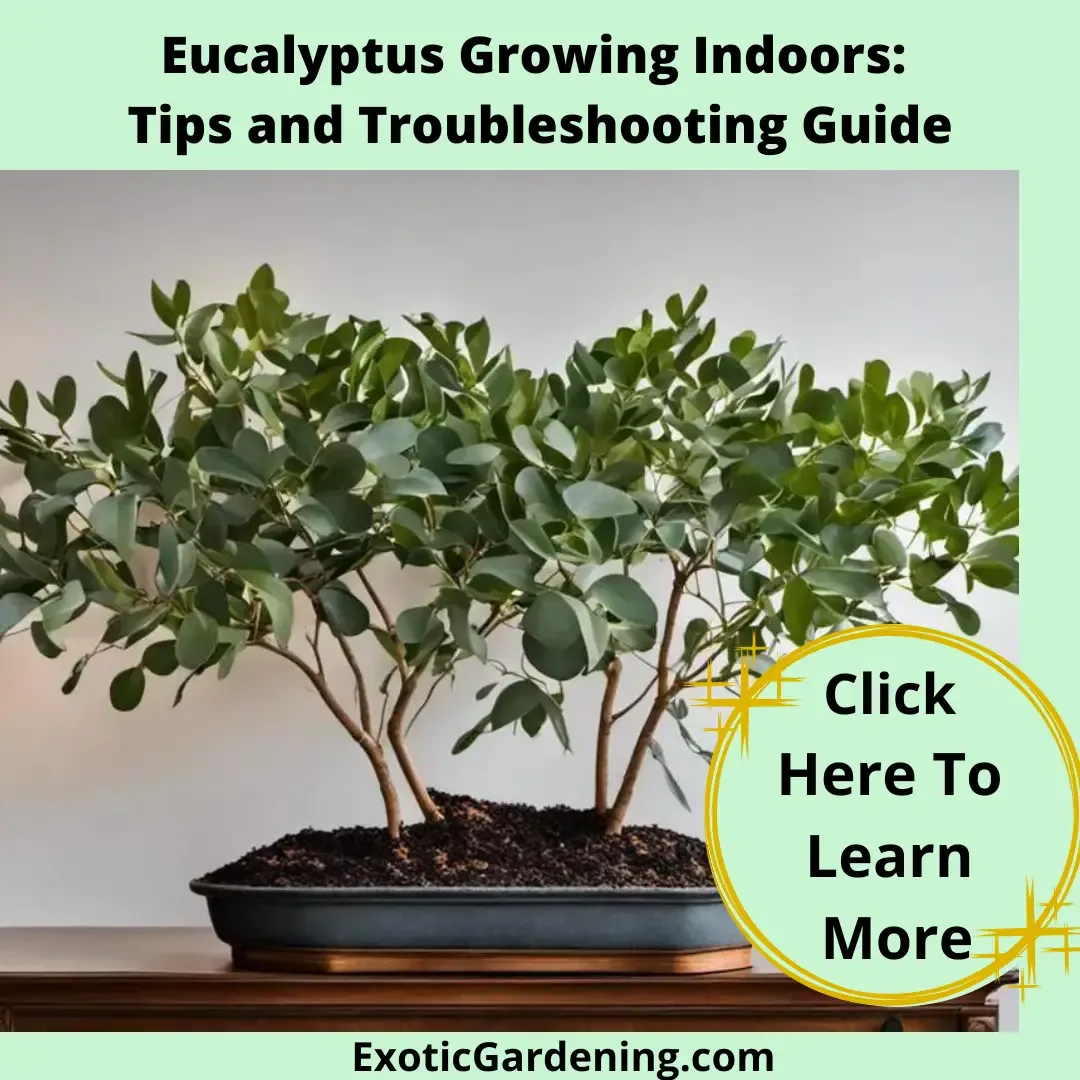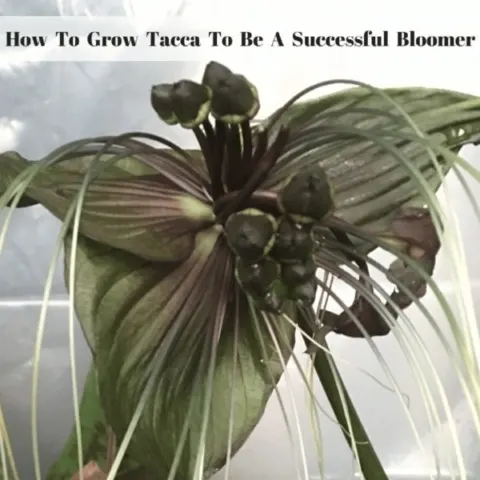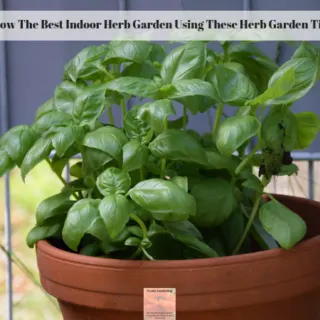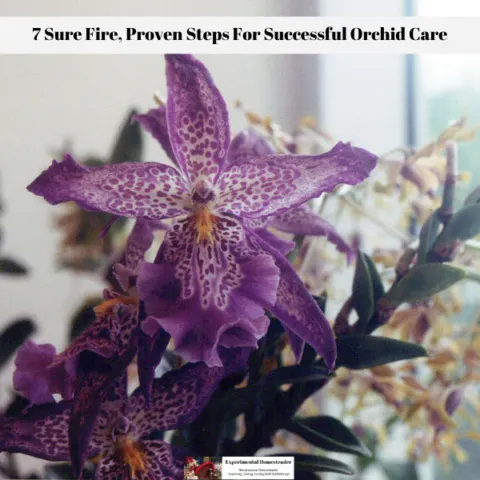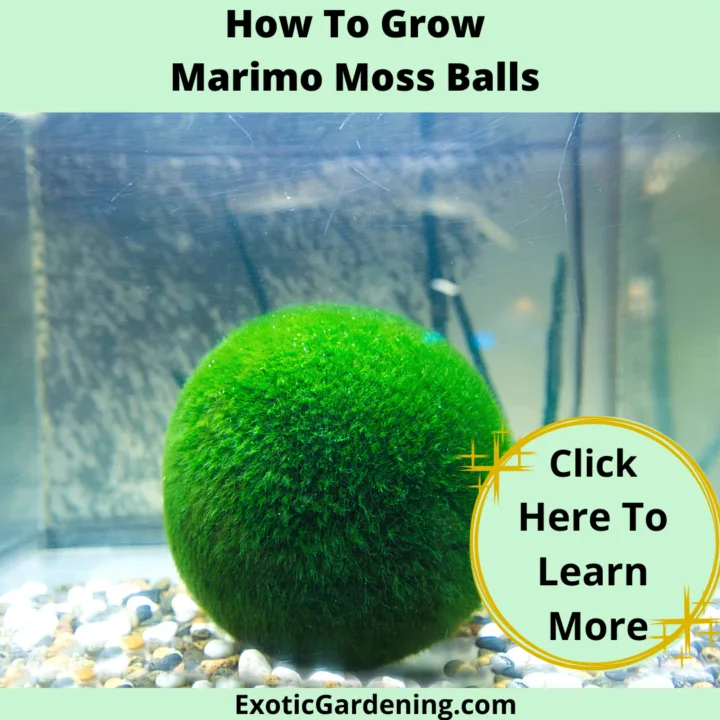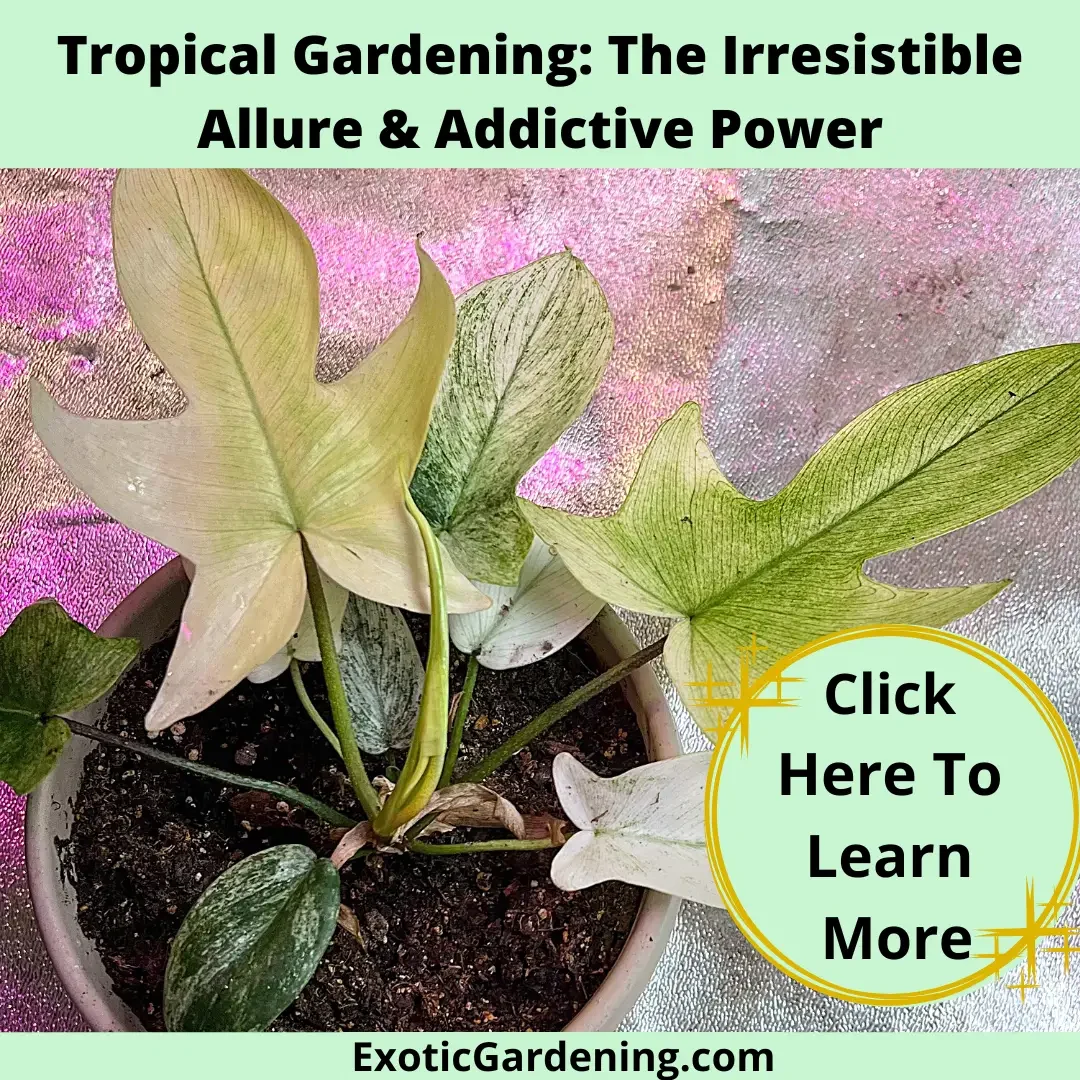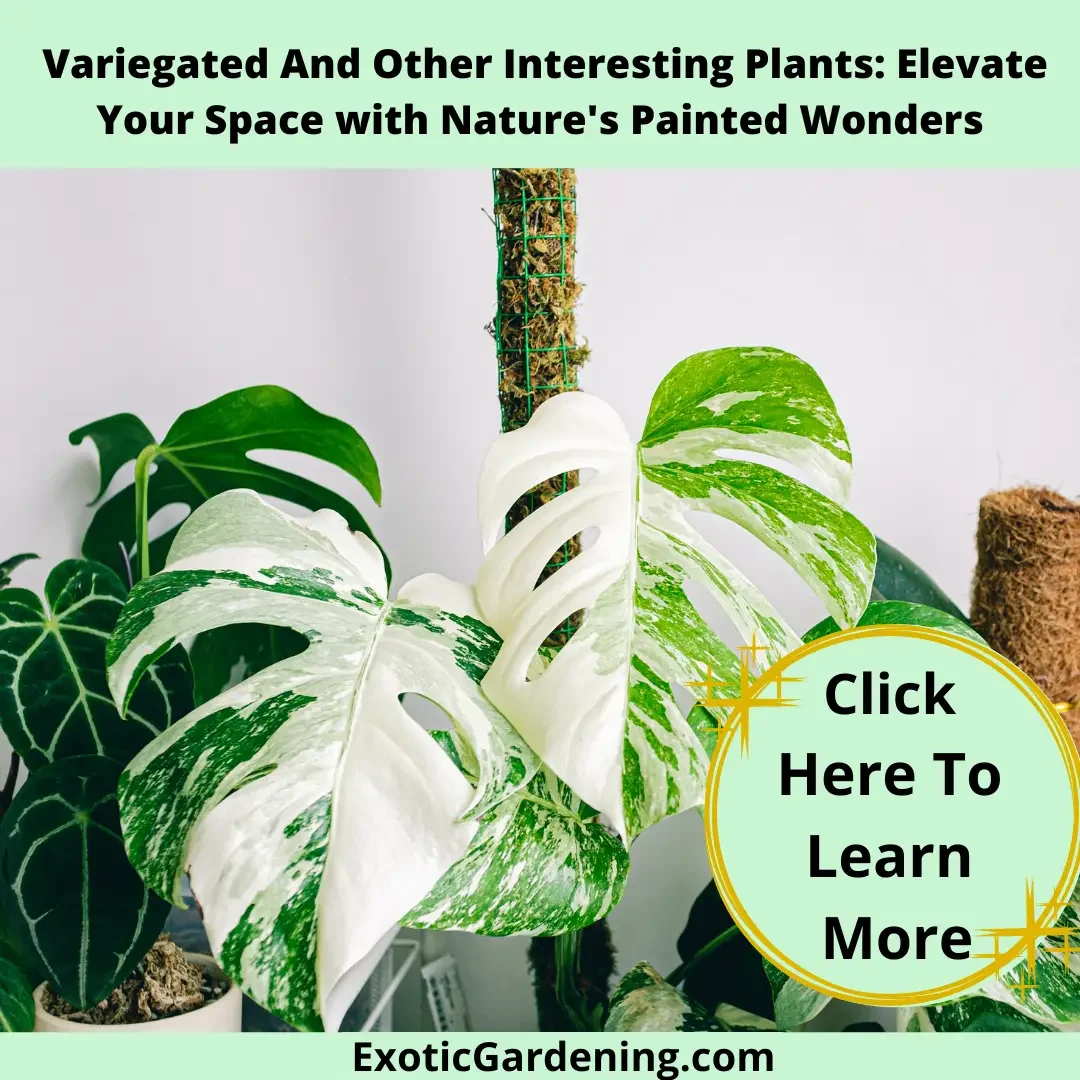In my ceaseless quest to banish the winter doldrums, I've discovered the captivating world of winter-blooming tropical houseplants.
Yes, you heard me right – tropical blooms that defy the cooler temperatures and bring life to the otherwise stark months of winter.
While we often admire the lush blossoms of summer, extending that beauty into the colder months indoors is not only possible but incredibly rewarding.
As the festive season approaches, what better way to infuse vibrancy into your living space and impress your houseguests with exotic, colorful blooms?
Today, I’ll introduce you to an enchanting selection of winter-blooming tropical houseplants that will transform your home into a lively sanctuary.
From rare botanical wonders to easily accessible delights, these plants are sure to brighten even the darkest winter days.
Why Choose Winter-Blooming Plants?
Winter can feel like an unending stretch of gray days, especially for gardening enthusiasts who thrive on the color, energy, and life of the growing season.
But what if you could bring that same vibrancy into your home during the cold months?
Winter-blooming tropical houseplants are the perfect solution to combat seasonal gloom and keep your love of gardening alive year-round.
These plants not only brighten your spaces but also offer unique qualities that make them a joy to grow and admire.
Here are some reasons why winter bloomers are a must-have for any plant enthusiast:
- Fragrance: Many winter bloomers emit delightful, sweet scents that can instantly elevate the ambiance of your home. Imagine stepping into a room filled with the subtle aroma of blossoms on a chilly winter morning—it’s like nature’s own air freshener.
- Resilience: Despite their exotic origins, tropical houseplants adapted for winter blooming are remarkably hardy. They thrive in indoor environments, enduring lower light levels and the drier air that often comes with central heating. With just a little care, these plants will reward you with lush blooms.
- Unique Aesthetics: Winter bloomers boast intricate shapes, vivid colors, and exotic appeal that make them stand out. From cascading vines of miniature wisteria to bold, fragrant flowers of Brunfelsia, these plants are true showstoppers that provide a fresh contrast to the bare, muted tones of the season.
- Mood Booster: The presence of vibrant plants and flowers has been shown to improve mental health, reduce stress, and enhance overall well-being. A splash of green and a burst of color can be just what you need to shake off the winter blues.
- Year-Round Gardening: For those who miss the activity of summer gardening, winter-blooming plants offer an opportunity to continue nurturing and tending to greenery even in the off-season. It’s a wonderful way to stay connected to nature and your passion for plants.
Whether you’re looking to add a pop of color to your living space, improve your indoor air quality, or simply indulge in your love of gardening, winter-blooming tropical houseplants are a fantastic choice.
They bring beauty, life, and warmth into your home, ensuring that even the darkest winter days are filled with nature’s magic.
Top Winter-Blooming Plants to Explore
If you're ready to brighten your home with tropical blooms this winter, you're in for a treat.
From cascading vines to compact shrubs, there’s a stunning array of winter-blooming plants that thrive indoors and bring a splash of color to your space.
Whether you're an experienced gardener or just starting your journey with houseplants, these winter bloomers are sure to captivate your heart and make your indoor spaces come alive.
Here’s a selection of some of the best winter-blooming plants to explore:
- Angelonia Salicariaefolia: With its fragrant, apple-scented leaves and delicate variegated flowers, this tropical shrub adds a touch of elegance to any room. It’s perfect for greenhouses or warm indoor spaces.
- Babiana (Baboon-Root): A South African beauty that produces clusters of brightly colored blooms, bringing a bold splash of color during the colder months.
- Centropogon (Handsome Crimson Basket Plant): Ideal for hanging baskets or creative edging, this plant’s vibrant red flowers are true winter showstoppers.
- Brunfelsia (Lady-of-the-Night): Known for its intoxicating nighttime fragrance, this shrub will charm your senses while its blooms brighten up the season.
- Hardenbergia (Miniature Wisteria): Perfect for adding vertical interest, this climbing plant boasts cascading flowers in shades of purple or white, offering a whimsical touch to any indoor space.
Each of these plants has its unique care needs, but all share the ability to bloom in winter, defying the season and filling your home with warmth and vitality.
Whether you want to experiment with rare tropical varieties or prefer more familiar options, these plants are your perfect winter companions.
Read on to discover specifics about each plant, including care tips and propagation secrets, so you can make the most of your winter garden!
Scented Elegance: Angelonia salicariaefolia
One of the first plants winter blooming houseplants to capture my attention was the fragrant Angelonia salicariaefolia, with its apple-scented leaves and enchanting variegated flowers.
This tropical flowering shrub thrives in greenhouses with temperatures between 60 and 65 degrees.
Due to its scarcity of seeds, propagation is best achieved through softwood cuttings, and keeping the soil moist is essential for its growth.
Its delightful blossoms appear in late winter or early spring, making it a perfect choice for anyone looking to extend their blooming season.
Care Tips:
- Light: Prefers bright, indirect light.
- Watering: Keep soil consistently moist but not waterlogged.
- Propagation: Use softwood cuttings for best results.
A South African Delight: Babiana
Hailing from South Africa, Babiana (commonly known as Baboon-Root) is a stunning cormous plant from the Iris family.
Its blooms, in shades of pink, lilac, red, or purple, cluster in groups of six, creating a striking display.
Babiana thrives in temperatures between 50 and 55 degrees, making it an ideal choice for cool conservatories or sheltered outdoor spaces in milder climates.
Care Tips:
- Planting: Plant corms in well-draining soil during the fall for winter blooms.
- Watering: Moderate watering; avoid waterlogging.
- Maintenance: Remove spent flowers to encourage prolonged blooming.
The Handsome Crimson Basket Plant: Centropogon
The Centropogon, often called the Handsome Crimson Basket Plant, is a shrubby creeper from the Lobelia family.
Its vibrant red flowers make it a showstopper for hanging baskets or as an edging plant around benches.
A creative touch can elevate its beauty: spread its stems gently and support them with bamboo stakes.
It blooms in winter, thriving in temperatures between 60 and 65 degrees.
For propagation, spring cuttings work best, but they require warmth (70 to 75 degrees) to root successfully.
Care Tips:
- Light: Partial shade is best, especially in summer.
- Watering: Keep soil evenly moist.
- Propagation: Use spring cuttings and maintain warm rooting temperatures.
Brunfelsia: The "Lady-of-the-Night"
Brunfelsia, also known as "Lady-of-the-Night," is prized for its intoxicating nighttime fragrance.
Native to the West Indies, this shrub blooms from fall to spring, showcasing delicate flowers that are a feast for the senses.
Growing up to three or four feet tall, Brunfelsia thrives in temperatures around 60 degrees.
Propagation is achieved through cuttings of ripened wood, either in the spring or fall.
Care Tips:
- Light: Partial shade to bright, indirect light.
- Watering: Regular watering; ensure soil is well-draining.
- Propagation: Use ripened wood cuttings for the best results.
Miniature Wisteria: Hardenbergia
The charming Hardenbergia, often called Miniature Wisteria, is a climbing plant with cascading flowers in shades of purple or white.
It’s perfect for adding vertical interest to your garden or indoor space.
Despite its modest size (12 to 15 feet), it delivers big on beauty, blooming from winter through spring.
Hardenbergia thrives in cooler conditions, around 50 degrees, and can be propagated using seeds or cuttings.
Care Tips:
- Support: Provide a trellis or other structure for climbing.
- Watering: Moderate; avoid overwatering.
- Propagation: Seeds or cuttings can be used to grow new plants.
How to Create a Winter Blooming Garden
Creating a garden full of vibrant blooms in the middle of winter is easier than you might think!
With a little planning and care, you can bring color, life, and even fragrance into your home or outdoor spaces during the colder months.
Don’t worry if you’re new to gardening—this is a project anyone can tackle with confidence.
Here’s how to get started:
- Choose the Right Plants
Start by picking winter blooming houseplants that fit your space and climate. Whether you have a sunny windowsill or a cozy greenhouse, there’s a plant for every situation. Look for forgiving varieties like cyclamen, amaryllis, or Christmas cactus if you’re a beginner. - Prepare the Soil
Healthy soil is key! Use well-draining potting mix for indoor plants to prevent soggy roots. If you’re planting outdoors, mix in compost or organic matter to enrich the soil—it’ll help your plants thrive even in the colder months. - Provide Adequate Light
Winter days are short, but that doesn’t mean your plants have to suffer. Place indoor plants near a bright window and consider using grow lights if needed. For outdoor plants, choose spots that get plenty of indirect sunlight during the day. - Monitor Temperatures
Keep an eye on temperature changes. Most winter bloomers prefer consistent warmth indoors or a sheltered spot outdoors. Protect outdoor plants from frost with row covers or mulch, and keep houseplants away from drafty windows or heating vents. - Regular Maintenance
Taking care of your plants doesn’t have to be overwhelming! Check the soil moisture regularly, water only when needed, and remove faded blooms to encourage fresh growth. A little attention goes a long way toward keeping your winter blooming houseplants healthy and happy.
Remember, every small effort adds up to big rewards.
Watching those cheerful blooms open during the dull days of winter is not just satisfying—it’s uplifting!
So, grab your gardening gloves, pick out a few winter bloomers, and start creating your own winter blooming garden today.
You’ll be amazed at how much joy it brings!
Benefits of Winter-Blooming Plants
Winter-blooming plants bring more than just beauty to your space; they offer a range of benefits that can positively impact your home, garden, and well-being.
Here’s why these plants are such a valuable addition:
1. Mental Health Boost
The gray, cold months of winter can feel never-ending, and for many, they bring a drop in mood or even Seasonal Affective Disorder (SAD).
Winter-blooming plants help combat this by adding vibrant colors and life to your environment.
Studies show that surrounding yourself with greenery and flowers can reduce stress, enhance creativity, and improve your overall outlook.
The cheerful sight of a blooming amaryllis on your windowsill or a bright hellebore in your garden bed can make even the darkest winter days feel lighter.
2. Pollinator Support
In regions where winters are mild, outdoor winter-blooming plants can provide critical support for pollinators.
Bees, butterflies, and other insects that emerge early in the season often struggle to find food when most plants are dormant.
By growing plants like winter jasmine or mahonia, you’re offering these essential creatures a reliable source of nectar and pollen, helping sustain the ecosystem during a challenging time.
3. Seasonal Interest
Winter landscapes often lack the lushness of spring or summer, but winter-blooming plants ensure your garden never feels dull.
These plants add texture, color, and variety when most other greenery has gone dormant.
From the vibrant purple flowers of Hardenbergia to the subtle charm of snowdrops, they create visual interest that lasts through the season.
Indoors, tropical winter bloomers like Angelonia or Christmas cactus provide a striking focal point for your décor, proving that beauty doesn’t have to hibernate.
4. Year-Round Gardening Joy
For gardening enthusiasts, winter-blooming plants extend the joy of nurturing and growing throughout the year.
They keep your gardening routine alive, giving you something to care for, admire, and look forward to during the colder months.
Whether you’re tending houseplants indoors or maintaining an outdoor winter garden, the sense of accomplishment from seeing flowers thrive in winter is immensely rewarding.
5. Improved Indoor Air Quality
Many winter-blooming houseplants, like peace lilies and orchids, also purify the air.
They help remove toxins and increase humidity, creating a healthier indoor environment.
This can be especially beneficial during winter when heating systems dry out the air.
6. Connection to Nature
Winter bloomers offer a comforting reminder that life and growth continue, even during the harshest seasons.
They help maintain a connection to the natural world, which can be grounding and restorative during a time when outdoor activity is often limited.
Adding winter-blooming plants to your space isn’t just about aesthetics—it’s a way to bring joy, support nature, and enhance your quality of life.
Whether you’re brightening your living room or creating a winter wonderland in your garden, these plants ensure there’s beauty to enjoy no matter the season.
Winter Gardening Pro Tips
Winter gardening can be a rewarding experience, and with a few extra tips, you can ensure your winter-blooming plants thrive throughout the season.
Here are some additional pro tips to help you create a flourishing winter garden:
- Use Mulch: Protect outdoor winter-blooming plants with a layer of mulch to insulate roots and retain moisture. Organic options like straw or shredded bark also enrich the soil.
- Invest in Quality Tools: High-quality pots, grow lights, pruning shears, and a reliable thermometer make winter plant care easier and more effective.
- Group Plants Wisely: Arrange plants with similar light, water, and temperature needs together to simplify maintenance and create supportive microclimates.
- Experiment with Tropicals: Grow exotic winter bloomers like Angelonia or bromeliads in a greenhouse or warm indoor space for a touch of the unexpected.
- Rotate Plants: Move potted plants outdoors on mild days for natural light and fresh air, but bring them in before nightfall to avoid frost damage.
- Monitor Humidity Levels: Indoor heating can dry out the air—use a humidifier, water trays, or group plants together to maintain humidity.
- Water Wisely: Allow soil to dry slightly between waterings, as most plants need less water in winter to avoid overwatering.
- Provide Frost Protection: Use frost cloths or row covers for outdoor plants on especially cold nights to shield them from freezing temperatures.
- Fertilize Lightly: Reduce or stop fertilizing most plants during winter. For winter bloomers, use a diluted fertilizer every few weeks to support flowers.
- Watch for Pests: Check plants regularly for pests like aphids or spider mites, and treat infestations with insecticidal soap or natural remedies.
- Use Reflective Surfaces: Position plants near mirrors or light-colored walls to maximize available sunlight during shorter winter days.
- Plan for Next Year: Take notes on which plants thrived and what you’d like to try in the future to prepare for an even better gardening season.
With these tips, you’ll create a thriving winter garden that stays healthy and vibrant all season long!
Your Winter Wonderland Awaits
Winter doesn’t have to be a season of gray skies and bare branches.
With the right winter-blooming plants, you can fill your home or garden with vibrant colors, enchanting fragrances, and a sense of life that defies the season’s chill.
Whether you’re drawn to rare tropical specimens or the classic charm of Christmas cactus, there’s a plant waiting to brighten your days.
Creating a winter garden is more than just a way to combat the dullness of the season—it’s an act of bringing joy, creativity, and a little bit of magic into your life.
Every bloom becomes a reminder that beauty thrives even in the toughest conditions, and each moment spent nurturing these plants brings warmth to the coldest days.
So, don’t let winter pass you by.
Dive into the exciting world of winter-blooming plants, and watch as your space transforms into a vibrant, lively sanctuary.
Whether you’re a seasoned gardener or just starting, these plants offer endless rewards.
Take the first step today, and let the wonder of winter blooms remind you that every season holds its own special charm.
Your garden, your sanctuary, and your winter wonderland are waiting—start planting!
Discover the Joy of Houseplants: Your Ultimate Resource Guide
Welcome to the ultimate guide for all things houseplants! Whether you’re a seasoned green thumb or just starting your indoor gardening journey, this curated list of articles has something for everyone. From detailed care instructions to creative decorating ideas, troubleshooting common issues, and learning about unique plant varieties, you’ll find everything you need to keep your indoor jungle thriving.
Explore topics like:
Essential care tips for popular houseplants.
Solutions to common problems like pests, watering mistakes, and lighting challenges.
Creative ways to display and style your plants.
Propagation guides to grow your collection.
Get inspired, troubleshoot challenges, and cultivate the lush, vibrant indoor space you’ve always dreamed of. Dive in and let your houseplants flourish with these helpful resources!
Mastering South-Facing Window Plants: Expert Tips for Your Lush Oasis
Discover the secrets of success with South-Facing Window Plants in our comprehensive guide. Transform your space into a green haven.
Transform Your Cozy Corner with these Perfect Plants for Small Spaces
Discover the beauty of compact gardening with our guide on choosing and caring for plants for small spaces.
The Complete Guide to Philodendron Pink Princess Care
Introducing the Philodendron Pink Princess
Allow me to introduce you to the crown jewel of my botanical collection – the enchanting Philodendron Pink Princess.
This recent addition is nothing short of a horticultural masterpiece, captivating the senses with its breathtaking display of colors.
Imagine deep, luxurious burgundy leaves, each adorned with bold splashes of vivacious pink.
The contrast is nothing short of a visual symphony, a natural work of art that commands attention.
As I gazed upon it for the first time, I couldn't help but marvel at the sheer beauty and grace that this plant exudes.
If you've never had the pleasure of setting your eyes on a Philodendron Pink Princess, consider yourself in for a treat beyond compare.
It's more than a plant; it's a showstopper, a conversation piece, and a living testament to the wonders of the natural world.
This captivating botanical gem promises to be a source of endless fascination and admiration in any space it graces.
Spider Plants: The Perfect Gateway Plant for Gardening Enthusiasts
Spider plants, the perfect gateway plant, add charm, purify air, and are ideal for beginners and seasoned gardeners alike.
Spider Plant Light Requirements: A Key to Growth
Explore Spider Plant light requirements for thriving indoor growth. Learn key tips for optimal lighting conditions and vibrant greenery.
How to Grow Spider Plants
Discover how to grow spider plants with expert tips on light, watering, soil, and more for thriving plants!
5 Creative Spider Plant Display Ideas for Your Home
Discover creative spider plant display ideas to elevate your home decor with unique, stunning, and easy-to-implement solutions.
5 Fun DIY Projects with Spider Plants
Explore creative DIY projects with Spider Plants, including terrariums, macramé hangers, and upcycled planters for vibrant decor.
10 Fascinating Facts About Spider Plants You Didn’t Know
Discover fascinating facts about spider plants, including their care, propagation, and unique qualities that make them standout houseplants.
Top 10 Common Spider Plant Problems and How to Fix Them
Discover solutions to common spider plant problems like brown tips, yellow leaves, and droopy growth to keep them thriving.
How to Propagate Spider Plants: A Step-by-Step Guide
Learn how to propagate spider plants with easy, step-by-step instructions to grow vibrant, healthy indoor plants effortlessly.
Rustic Interior Decorating Idea With Tropical Plants
Metal cages or even old bird cages filled with plants are a great way to add a rustic touch to your interior decor.
Plumeria: The Lei Flower Is A Fragrant, Easy To Grow Houseplant
Learn how to care for your Plumeria in ground and in containers. Because of the winter dormancy period it is ideal for summer containers.
Indoor Flowering Tropical Plants
There are a number of indoor flowering tropical plants that are easy to care for and bloom all winter long under the right conditions.
How To Grow Boswellia sacra
Boswellia sacra is the plant frankincense tears comes from. Learn how to grow the Boswellia sacra plant and what the various uses for it are.
6 Easy Tips On How To Care For Plants
Proper plant maintenance is essential if you want to learn how to grow healthy plants. Check out these six tips on how to care for plants.
Beneficial Indoor Gardening Plants You Need To Know
Learn about indoor gardening beneficial plants that are edible, help heal minor cuts or burns or those that help remove impurities from the indoor air.
How To Choose The Right House Plants For Indoor Gardening
Choosing the right plants for an indoor gardening environment is important for success. Many indoor gardening house plants are easy to care for.
How To Care For Holiday Plants
Have you ever wondered how to care for holiday plants such as the Poinsettia or the Christmas Cactus? If so, then check out this holiday plant care guide
Understanding and Treating Plant Blight: The In-depth Guide
Master treating plant blight with expert tips. Learn to protect your garden from this common threat. Essential insights inside.
Fall Tropical Plant Care: Transitioning Your Tropical Treasures in Autumn
Discover the secrets of successful Fall Tropical Plant Care. Learn how to transition your exotic plants for a thriving winter indoors.
Eucalyptus Growing Indoors: Tips and Troubleshooting Guide
Discover the art of eucalyptus growing indoors for year-round beauty and fragrant cut foliage in your flower arrangements.
When to use Fluval Stratum for Houseplants
Discover the perfect timing to use Fluval Stratum for houseplants and unlock vibrant growth in your indoor oasis. Learn more here.
How To Grow Bay Leaves Indoors
Discover the secrets of successful gardening with our guide on how to grow bay leaves indoors. Cultivate your own aromatic herb garden!
Easy Exotic Houseplants: Tropicals That Thrive Indoors in Containers
Tropical plants are the most beautiful, easy to grow indoor houseplants. Start growing exotic houseplants today that fruit and flower!
Tips For Making A Moth Orchid Last From Costa Farms
Successful orchid care is pretty easy once you understand the seven basic steps the plant needs to thrive in your home environment.
Meet The Exotic Pitcher Plants - Sarraceniaceae, Nepenthaceae And Cephalotaceae
Learn about the exotic pitcher plants known as Sarraceniaceae, Nepenthaceae And Cephalotaceae including how to propagate them.
How To Grow Marimo Moss Balls
Learn how to grow Marimo Moss Balls and how to care for a moss ball to keep it happy. A Luffy ball is a very low maintenance plant.
Tropical Gardening: The Irresistible Allure & Addictive Power
Unveil the Addictive Allure of Tropical Gardening – From Starter Plants to Care Tips. Dive into #TropicalGardening!
Variegated And Other Interesting Plants: Elevate Your Space with Nature's Painted Wonders
Explore the world of variegated and unique plants, adding vibrant beauty and intrigue to your indoor oasis.
Tropical Plants For Medium To High Light
Check out these awesome tropcial plants for medium to high light that make wonderful, easy to care for houseplants.
How To Grow Tropical Plants
Growing tropical plants - also known as houseplants - indoors is fun and enjoyable plus many of them clean the indoor of pollutants.
It is easy to grow exotic looking plants that produce tropical fruit and colorful flowers in a pot in your living room or office.
Many of these plants are easy to start from seed and I share with you five plants that I recommend for indoor growing.
I also share with you why growing your own tropical fruit saves money.
In this video you will learn:
How to bring tropical plants indoors at the end of summer
How to grow tropical plants indoors
How to protect and overwinter tropical plants outdoors in cold climates
How to propagate tropical plants
How to water tropcial plants
How to grow topical plants in a greenhouse


